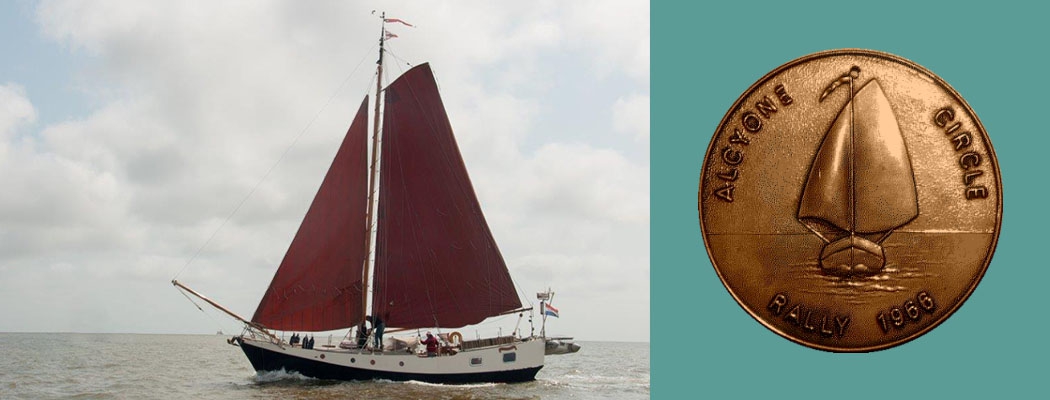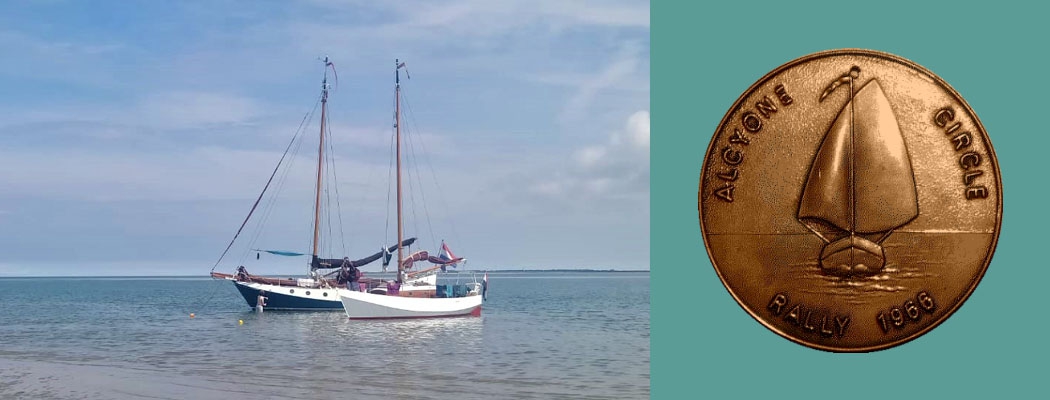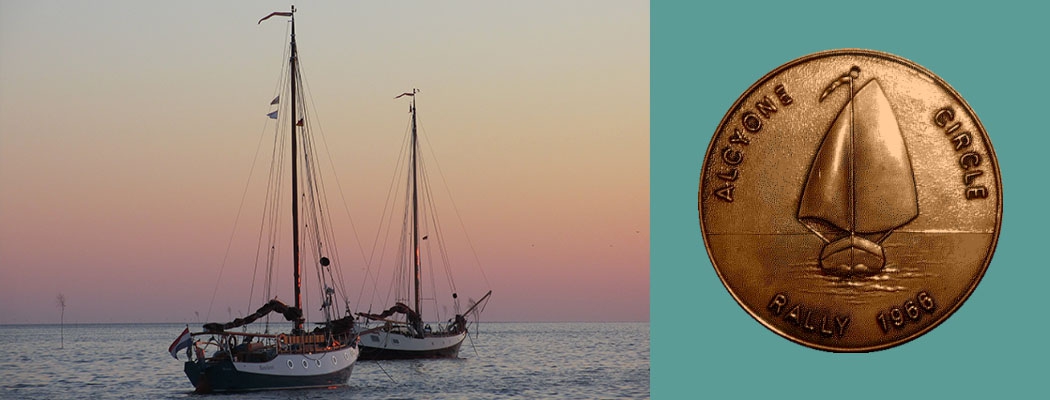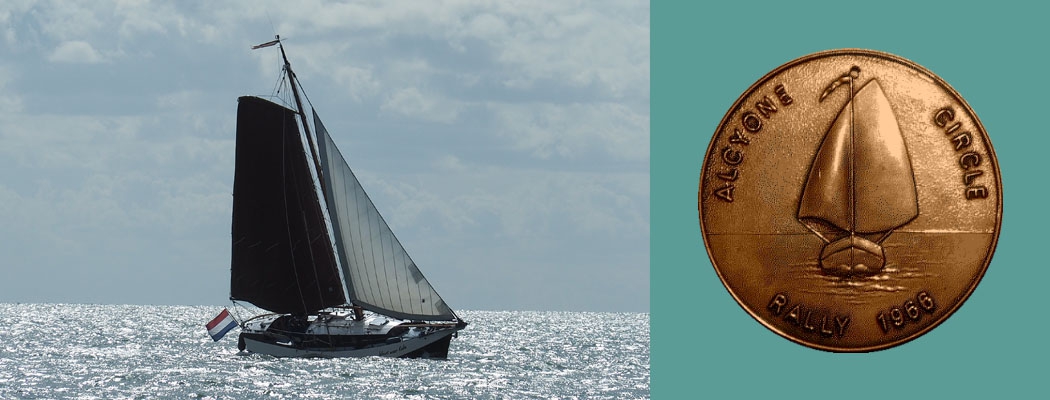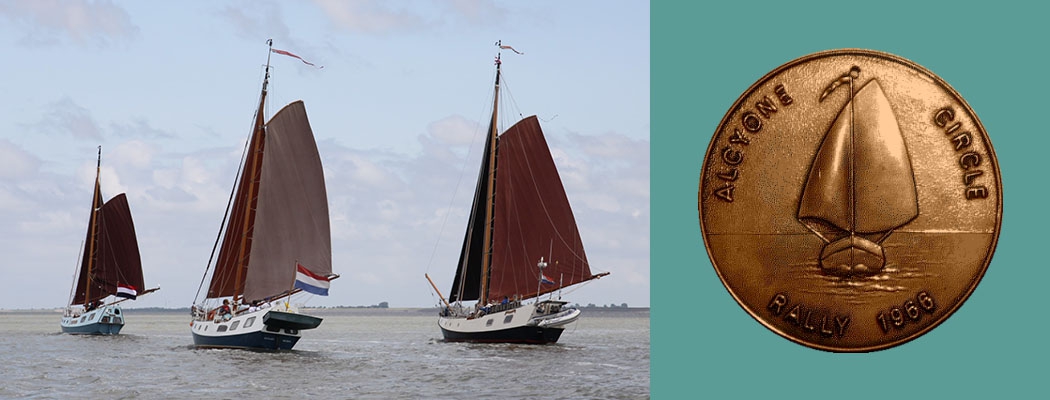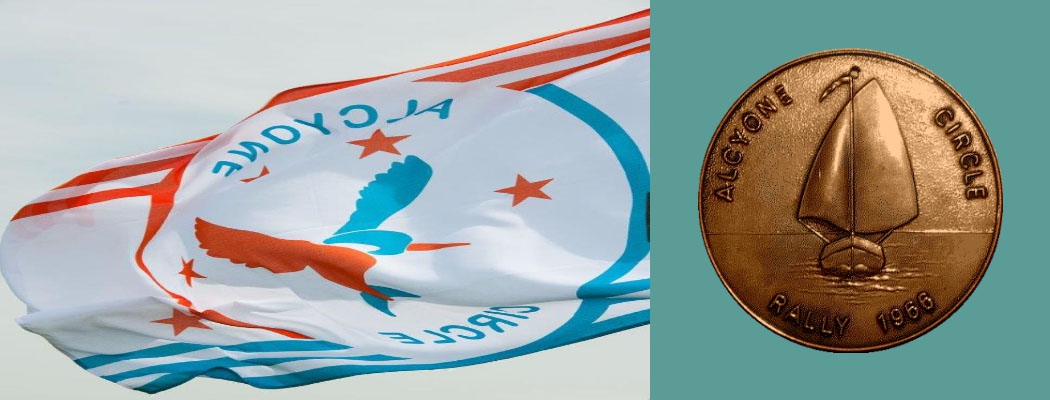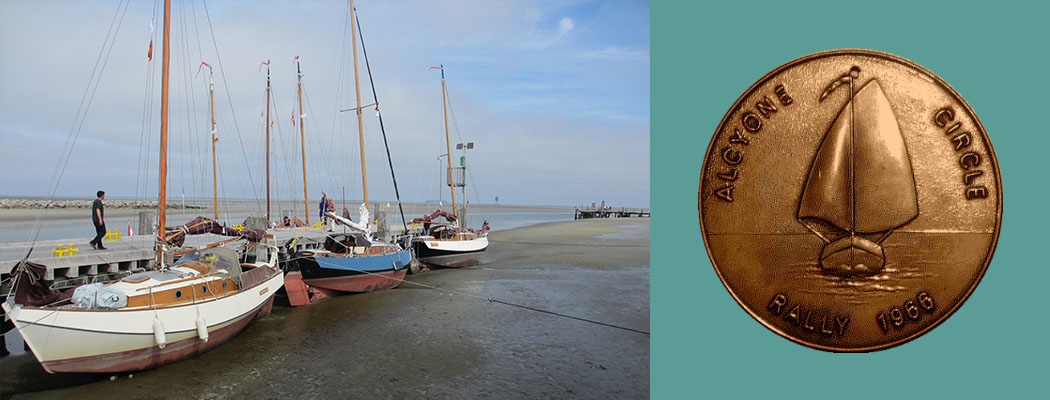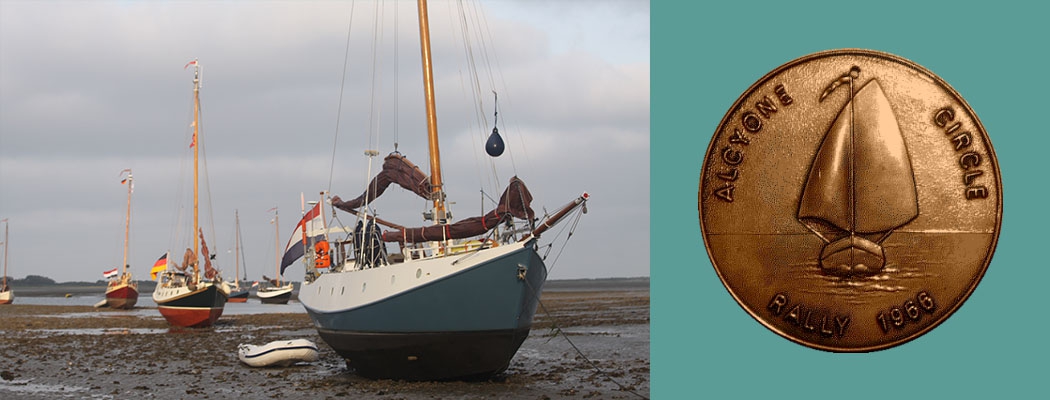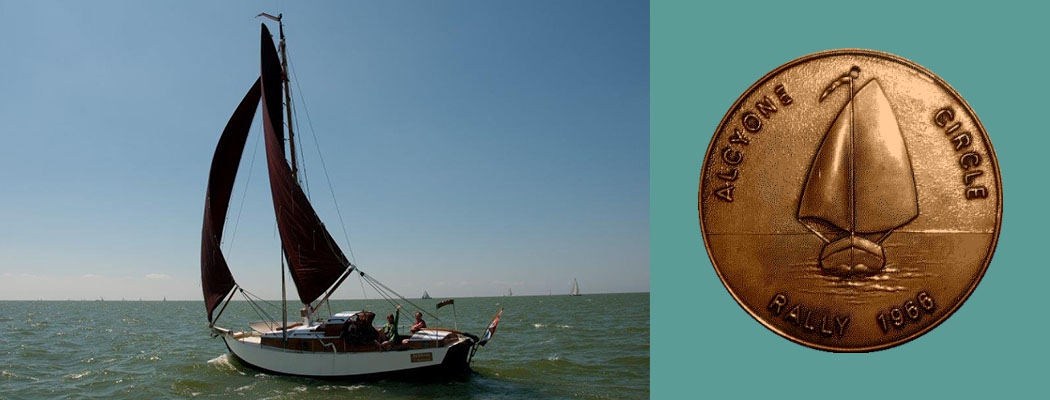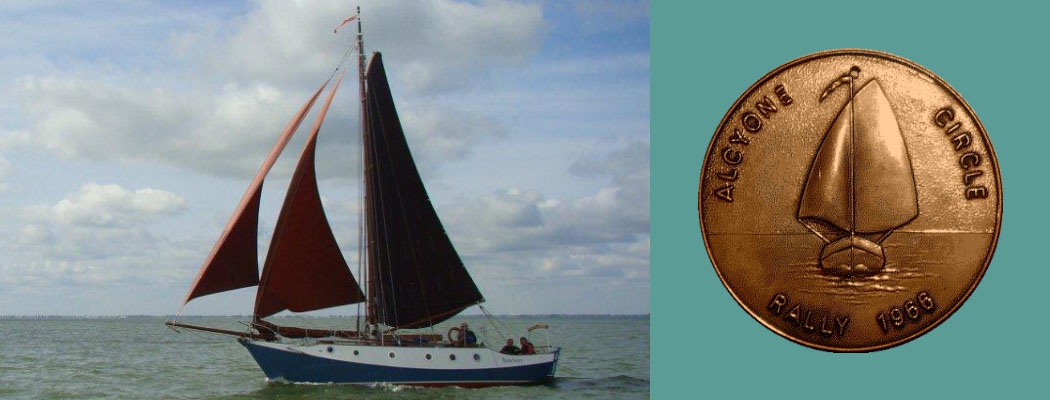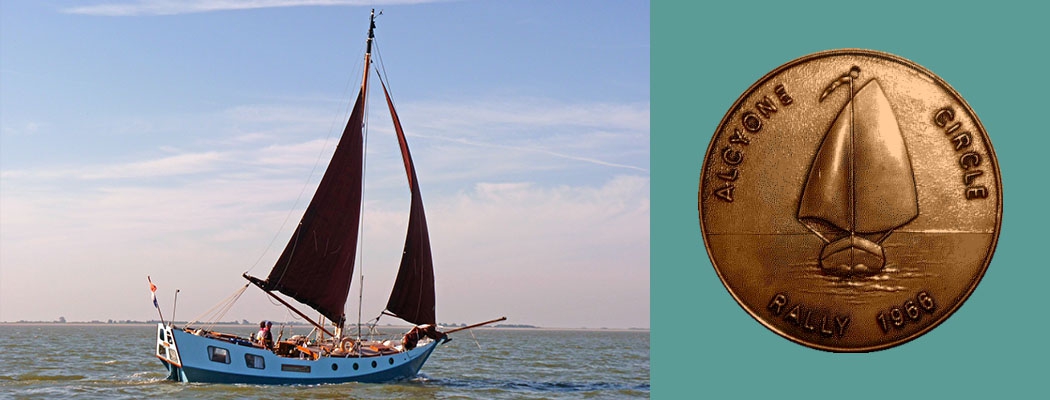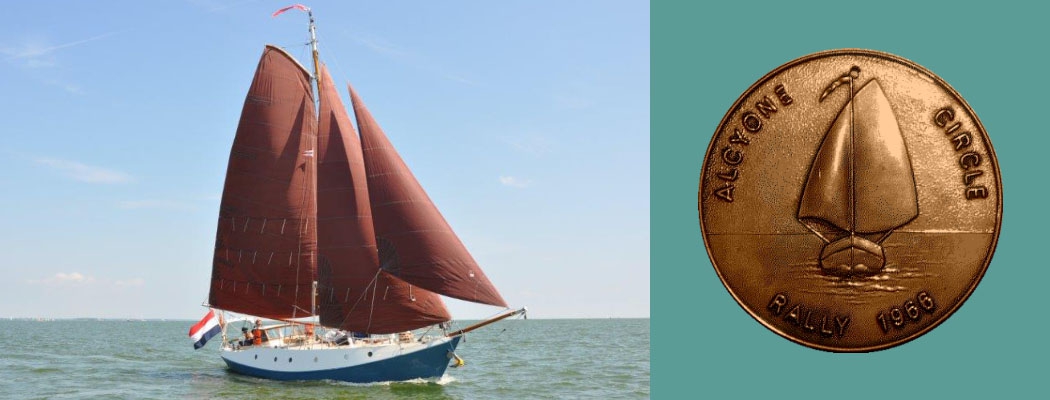 News from Valentijn Shipyard.
News from Valentijn Shipyard.
Valentijn Shipyard presented a beautiful medal to the owners who joined the rally 1964. It is a nice remembrance to that successful event and so it was a wonderful surprise.
The building program has been considerably changed. Three ships of the Alcyone II class, one ship of the Alcyone I class and twos hips of the Cormorant class will be built.
New members
The following owners and prospective owners have since last Newsletter joined our Circle:
Mr. William B. Bodine (America) Alcyone I class ship
12 Reistrasze (Dotsheim)
Wiesbaden.
Jhr. E. G. Sandberg “Oogwaai” (ex Duyfke)
Blauwe Kamerlaan 5
Den Haag.
Mr. H. P. Sturm (British) Alcyone II class ship
Patrijzennest 2
Gorinchem.
F. C. Doodeheefver Alcyone II class ship
Zwaluwenweg 23
Blaricum.
Ir. A. C. Dros Alcyone II class ship
Huygenslaan 2
Amersfoort.
Mr. D. B. Rouse (British) “Milly Dolly”
Goodshelter House
East Portlemouth Salcombe Devon
England.
Mevrouw I. Weisbach-Junk “Phoca”
Van Stolkweg 13
Den Haag.
Our new members are very welcome and we hope that they feel happy in our Circle.
Cormorant Class.
Although there are now nearly a dozen of “cormorants” I have up till now never received any copy about these ships. For the benefit of those owners who have never been to sea with their ships it will be very interesting to read something about the behaviour of the Cormorants at sea. Next to that it will be interesting too if something was told about improvements or alterations which proved to be an asset.
Rally 1966
The rally 1966 will be held on the 30th and 31st of July in the vicinity of Flushing. Twenty or even more ships attending this rally must be expected and that means about a hundred people. So yachtharbours and restaurants near Flushing, Veerse Meer and Zieriksee have to be inspected and reservations made before it can be told where the rally 1966 will be held. It must not to be forgotten that even if the ships are moored four alongside, there will be five rows and so about 200 feet of quayage will be needed.
News about Yachts
Captain Sanders made me very happy with his article about new equipment, which follows underneath.
Blue Griffin – some comments on new equipment
Automatic Pilot. This was installed with the trade name PINTA only just before starting the 1965 long cruise and modifications will be made during the current winter. This is a most simple design, virtually foolproof and not liable to troubles that might be associated with delicate electronics. It includes a compass unit which, contrary to some systems, can be placed also anywhere, not withstanding the steel hull. In fact it has been placed in the starboard locker in the cockpit. The motor to drive the short horizontal shaft (to which is attached both the tiller and the drum carrying wires to the rudder head) is placed on the cockpit seat, immediately to starboard of this shaft, and an 8” diameter sprocket wheel in two halves is bolted to that shaft. The only remaining unit is the control box which is fastened to a bulkhead below. There is no unit attached to the rudder in any way.
The method of operation is to put the yacht on the desired course in the ordinary way, and having steadied her, to clutch in the motor and just “leave it to Pinta”. It is not possible to set a course on the compass unit and leave it to Pinta to alter course to that new course. There are systems that will do this, but they involve an additional unit attached to the rudder and are possibly more delicate and expensive. There is a sensitivity adjustment, and when set fine a straight course down a canal can be achieved (should anyone be fool enough to want to want to do that!) or in rough weather, the course setting will drive the yacht within a wander of about 5º, but much less in fine weather. In short it is a joy being able to steer very much better then any of us humans can.
Many Dutch yachts have been fitted with PINTA, manufactured by the Marine Automatic Pilots Ltd, Hove, England, and one of the Directors is often in Holland carrying out installations.
Alternator. Blue Griffin’s engine is the Perkins 4/99 and fitted with the usual dynamo with a maximum output of 11 amps. Over the past five seasons this has proved adequate to charge two separate 12 Volt batteries (one for starting, and the other for all other services). With the increased consumption required by PINTA and the tendency to increase other equipment, during the previous winter a Prestolite alternator has replaced the dynamo. This is about the same size though different shape, and after a good deal of cogitation, was attached to an adjusted bracket in the same position using, curiously, the same driving belt as the dynamo. The wiring had to be adapted to include a new regulator and relay (small items to fasten anywhere) and to allow for the new maximum charge rate of 40 amps. This device is being increasingly fitted to motorcars, and has every advantage over a dynamo for yachts.
Tiller locking brake. For five seasons Blue Griffin’s tiller has been lashed, when appropriate with cord, but it always seemed that some much more convenient and easily adjusted permanent device was needed. After a worm and wormwheel device had been designed and discarded, a much simpler system was evolved, made and fitted with most beneficial results. Other Pavilion yachts have a device of this sort. Blue Griffin has a 8” diam. wooden drum attached to the horizontal tiller shaft in the cockpit, and on this drum two Ferodo small car brake drum shoes have been wood screwed. Two phosphor bronze brake bands were made and connected on one side with an adjustable link, and on the other side by a snap action toggle the hinge of which is secured to the wooden cockpit seat. This by a single operation of the toggle lever (over dead centre) the brake is brought into operation. If the adjustable link is set average, the tiller can be manually forced to a new position, but if the weather helm forces are too great, the adjustment can be altered to hold the tiller as required.
Refrigerator. Advantage was taken of the production by Electrolux of a new small model to fit one to Blue Griffin last winter. The provision of this equipment had been part of the original requirement when Blue Griffin was built, but the Valentijns, at the time, had to confess defeat in finding room. In the present case, a good deal of structural alteration in wood was necessary, but it was eventually squeezed in. This model can be operated by gas or electricity or both. Electricity was thought, before the decision to fit an alternator was made, to be impossible on grounds of consumption. After a season’s use, during which this item has worked perfectly, it is an open question whether the space occupied, the trouble in fitting it or the cost, was really worth it. When cruising in Holland, fresh food is available daily, and only butter was the important improvement. All gas types are said to be unworkable and liable to improvement. All gas types are said to be unworkable and liable to important damage when tilted more then 5º. Most sailing yachtsmen ignore this, apparently with impunity, though it is true that no cooling results when heeled over for long periods in passage.
Balanced rudder. Like all pre-1964 Valentijn yachts, Blue Griffin is “hard headed” with considerable weather helm. The remedy, as all have no doubt found, is to reef early and/or keep the largest headsail set. Without in anyway reducing the necessity for large helm forces on occasion (like squalls etc.) the actual force on the tiller can be reduced, if the rudder can be balanced. Since it did not seem practical to cut the deadwood aft (and alter the propeller etc.) to enable the rudder to have an area forward of its pivot, in Blue Griffin (and with Max Gunning’s blessing) two vertical blades, each 30” high and 5” fore and aft, were attached rigidly to the existing rudder. Each blade was easily shaped in wood to hydrofoil section and attached on either side, each being 10” out from the rudder and with the trailing edge level with the forward vertical edge of the rudder post. This arrangement clears the propeller when hard over, and provides an area of nearly 2 1/2 square feet of balance before the pivot. After a season’s sailing, the result has been proved undoubtedly beneficial though small.
Bowsprit. Though it is probably clear that the new design of Valentijn yachts with a cut away forefoot has solved the weather helm problem (and provided fasted and better sailing thereby), probably the simplest method available to the “old timers” is to increase the sail area forward of the mast by fitting a bowsprit and jib. In Blue Griffin this has always been obvious but with the difficulty of circumventing the pulpit, and the necessity to have an easily housed spar, the final design (and the effort to carry it out) has been lacking. Now however the problem is Again the fore, and possibly by the time that the Alcyone Circle meets in 1966, Blue Griffin may be seen rigger as a cutter. A wooden cannon to make soke and a bang is also on its way to the drawing board, but the Bowsprit is more important and useful.
Logs.
Captain Sanders and Sir Percy Wyn Harris kindly send me their personal log of respectively Blue Griffin’s Dutch Cruise 1965 and Spurwing crossing the Atlantic from Gambia to Barbados (West Indies). I want to thank very much the authors for their kind gestures.
Blue Griffin’s Dutch Cruise, 1965
As a Dutch built ship it was only natural for her again to cruise in Holland, a flat land (where it isn’t water) without inspiring scenery but a delight for craft of every description and a land where yachts and yachtsmen are more than welcome.
The cruise was to start from Upnor on Thursday, July 22nd, in order to make sure of reaching Ostend for duty free supplies and through to Walcheren canal before the Sunday delays. So the skipper and Max were on board by 12:30 with michael and Pamela following in time to skip by 16:00 with a SW wind. force 4.
Through the wind backed a bit, by midnight to South, it enabled a fast engine free passage of 18 hours for the 90 miles. Stores that had been ordered beforehand, rest and refreshment were all secured in time to pay the standard visit to the Belgica for a fish dinner and on to the White Horse for gaiety.
Jo, who had been unable to get away before the end of the week, came over by the night boat and joined at 5:00 in time in theory, though not in practice, to have breakfast ready for the planned 6:00 start for Holland. The wind had veered to NW force 5 and it seemed that a fast run under genoa only towards the Roompot entrance to Zierikzee would eventuate. But mal-de-mer decreed otherwise, and after the minor race off Zeebrugge has laid out at least two of the crew, it was decided to make the shorter exposed passage to Flushing. After arrival at 11:00 we were told to report to both the customs and immigration offices (same building) and then on to Veere, arriving 15:30.
The plot at this stage was to reach the yacht’s building yard as soon as possible, allow two days for various jobs, and leave enough time to penetrate the Wadden Zee as far as possible (Borkum had been in the sights) before Michael and Pamela had to leave on August 7th. By the flushing entrance it seemed that a day had been lost, but by careful consideration of the tides, it was decided to sail the next morning (Sunday) at 5:00, blow through the Zandkreek (or Veerschemeer) with the wind still SW (4) behind us and tale the fleet to Willemstad, thus catching up with the previous plan. This trip afforded a four hour passage to a pigeon which consumed an incredible amount of bread and water. This example was followed by a dinner ashore at the Wapen van Willemstad.
Taking the last of the flood the next day to Dorderecht, meant a 11:30 start, and the mast was lowered at Dordrecht for a motor run through the Gouda locks to Alphen where at 20:30 we stopped for the night secured to trees. An 8:00 start the next morning took us to Langeraar where Blue Griffin was Built, but unfortunately the rain arrived in torrents at the same time. What had been meant to be a few simple jobs turned out to be a complete strip of all paint below the water line and six coats of various kinds to replace. This, with the other jobs, took three days though this included going up and down (with a crash into the opposite bank both times) two slips.
Max, who had left us at Alphen returned with father-in-law’s car and took the crew on a sight seeing trip to Amsterdam, and the following day Jo went with a yard to Limburg. The crew for Alcyone arrived to sail her to England after repairs, and this, with builder’s entertainment was too much for the abstemious skipper who had to retire to his bunk before all the guests had left. On another evening the crew had to read English passages for a tape recording for the benefit of Butch Martin’s English speaking.
By Friday noon all was finished and we sailed for Muiden via Omval but were plagued with having to clean frequently the new water filter. At Muiden we berthed on the Commodore’s yacht under the instruction of old friend Van Merle, who happened to be the O.O.D. Saturday took us to Hoorn (that no fresh visitor to the IJsselmeer may miss) and with the mast up again we experimented calmly with Pinta, the new toy fitted only the weekend before leaving England. This is an automatic pilot.
Pinta is an extravagance that might seem different to justify in a 14 ton sailing sloop, especially one with a “whipstaff” type steering. However the skipper loves gadgets. It turned out that the electric consumption is 2 amps when just switched on and 9 amps when the motor decides to move. When just switched on and 9 amps the motor decides to move. When the only (main) engine is in use with its alternator capable of 40 amps this consumption presents no problem. As we had sailed across the North Sea without engine, we had refrained from using Pinta other than for periods for test. It seemed to have its limitations and at the time of writing these have not yet been ironed out but the skipper is in no doubt that they will be.
At Hoorn where we dined at the Wapen van Hoorn (den Waag was full) we met the Pearces in Dorothy Maureen and our sister ship “Oogwaai” late Duyfke. The next morning Oogwaai and Blue Griffin left in style in line ahead, 30 yard interval, with the Royal Marine Band playing on Blue Griffin’s poop. They (or rather it) fell off, luckily on to the chart table, and stopped abruptly but actually rather suitably as the squadron was then outside and heeling to a reefing wind. Fine weather now firmly with us and a fast run took us to Hondelopen by 17:00 and on the next morning at 1200 (conditioned by tide in the Wadden Sea) to enter Terschelling at 18:00. Here after 300 miles a day of rest seemed appropriate and we met the crew of Alghere which we had known under former owners in the Midway.
Not only had Michael and Pamela to leave on the 7th, but it had been arranged that their replacements should join at Leeuwarden that day. This fixed point decreed that both Borkum and Schiermonnikoog were “out” but Ameland was possible, so on Wednesday (aug. 4th) this task was attempted. There is no published detail information about the water depths over the “Wantijs” (watersheds) behind the islands, but the latest Dutch charts (which we had) do show the channels. We started on what appeared to be the direct route over a Wantij to Ameland to Ameland where we intended to spend the night either at anchor or on the bottom, dried out alongside the pier. Blue Griffin draws just under one metre, and just under two keel down, affording good warning, in a addition to the Hecta sounder, though this would have to be calibrated in inches to be really useful here.
The difficulty with these wantij trips is that one must cross near enough to H.W. to get the water, but if one does have to dry out, it will be the best part of 12 hours before floating again, though L.W. state will reveal with great clarity the best path to follow in due course. In our case H.W. was about 1300 and a refloatation at night would be useless – the buoys are not lit – and so after a few bumps with the keels half up, we thought discretion was better and we turned and fled through the riepel channel to Harlingen arriving a day earlier then we had intended, but as it turned out most fortunately.
Here it was necessary to take steps to replenish the Calor gas supply. Two 32 lb cylinders are carried and both were full when leaving England. In previous years these two had just covered all requirements for a 4/5 week cruise, but last winter a refrigerator had been fitted, with the result, as then discovered, that one cylinder would last a bare fortnight. Whereas in England replenishment is by replacement, as also on the Continent, no cylinders with appropriate fittings are available abroad, and so it is necessary to refill the English cylinder. We had had no experience of this performance before, and at Harlingen a day was wasted in an unsuccessful attempt to achieve this process. On reflection this may have been due to difference in the colour of the two distinct types, for propane and butane (Calor) which, in Holland, is reversed. However on proceeding to Franeker, along the canal to Leeuwarden, and making the necessary explanation, a refill was achieved without difficult or delay.
At Franeker we also visited again the oldest planetarium in the world, constructed by Eise Eisinga in 1768. We were told that Eisinga who had the planetarium when only 24, was a woolcomber by trade all his life and constructed this extraordinary “machine” in the ceiling of his small house perhaps to demonstrate the falsity of a current panic that the end of the world would come when it happened that year that all the then known planets with the moon would appear under the sign of aries.
Leeuwarden was thus reached on Friday (Aug. 6th) to berth in quite the most splendid yacht harbour in Holland, if not very much further afield. Accommodation is given to just on 1,000 yachts, many of them under cover. All “basins” are surrounded with carefully tended lawns, trees, hardens and properly macadamized roads and paths connect. All this is of course municipal no club could possibly afford this scale. Leeuwarden is the provincial capital of Friesland, and the only industrial town, its industry being all connected with milk and agriculture. The opportunity was taken to fill up with diesel oil at 1/4 per gallon – far the cheapest we had met.
Here Michael and Pamela left to return to England, Pamela by steamer, and Michael via another yacht from Dordrecht. They were replaced by Ronnie, son Charles (14) and friend Nicholas (15). Here also the weather which for a few days had been merely pleasant decided to pull out all the stops, and for the next week at least the sun shone and we swam frequently.
The plan was to escape from bridges (none open in Friesland) on Sundays) and so the night was spent alongside the Prinsenhof hotel where we also dined. This is holiday Holland in a big way but the myriad water channels easily absorb the clouds of yachts, big and small. Sunday took us to Grouw where we had a most hilarious party with the Kidds in the Brave Hendrik and learned something of the lighter side of English/Dutch relations. Separately two Dutch doctors were entertained to dinner on board.
While proceeding the next day to Lemmer the throttle cable broke, luckily not at a moment of navigational tension , and an hour with the soldering iron restored matters. A note in the log records that even a mended throttle cable will not take one through a fixed bridge – with the mast up.
Friends at Lemmer seemed to be away on holiday, so we sailed on to look at Urk. The look was fair enough but the smell of fish was too much, so without lowering so much as one sail, we entered and left to go on to Kampen. No doubt some days could well be spent exploring this lovely region, but with another fixed point ahead for a crew change, after finding a quiet spot for the night, and seen the beautifully illuminated bridge, we went on the next day to Elburg. Very few people seem to go there, though, as a walled town, it is larger and more interesting than Willemstad. Formerly a sea port with the usual wooden pierheads, there are now to be seen high and dry in the new polder which has the new waterway (Valeuwemeer) between the town and the old pierheads. After dinner ashore at the Stad Elburg, we went on the next day to visit Harderwijk and with the intention of reaching Spakenburg where we had arranged to meet a Dutch family (van Rossums), old friends.
From Elburg to Harderwijk the waterway between the mainland and the polder is the Veluwemeer, adapted now for recreation of all sorts, the Northern bank (facing South) being 20 miles of superb sand and suitable for almost unlimited camping and swimming. The sand shelf, being artificial, dips suddenly, and when we anchored to swim, we had 2 ft one side and 10 ft the other. Unfortunately Jo tried a dive on the wrong side with disastrous results to his right thumb, not to mention a head and arm shake-up.
Spakenburg had to be abandoned as there was then no way of getting there without a 15 mile run to the first, and shortly to be closed, hole in the wall out of the polder, opposite Huizen and then a 5 mile sail back. The hole in the wall, opposite the Eem river had been closed only the previous week. Before reaching the hole opposite Huizen, a botter was found in distress with no engine and on the lee shore of the wall. Though we had bumped across 10 miles of the IJsselmeer (to be the next polder) in water as shallow as 4 ft we decided that an attempt at rescue should be made, and after an abortive attempt to float in a tow line, we ventured close enough to throw, and successfully towed her off into deeper water.
Having telephones the van Rossums, the family of Pa, Ma and three kids (2, 4 and 5) were embarked at Huizen for the 12 mile run to Muiden. For this with the wind aft and a soldier’s wind out of Huizen and into Muiden, all adults were laid off, and Nicholas was appointed acting skipper with Charles to take his orders. Only the genoa was used to leave room for the children to roam about (on strings) and the adults to drink and relax.
At Muiden Roderick arrived to join the crew and replace Jo who had to leave for England after three weeks aboard. Muiden Castle was visited, and in the afternoon (Saturday) instead of pressing on for home, the weather being still “off shirt” style, and having met the Van der Ploegs in Banckert, a quick run in company to Monikkendam was inserted, though the further forecast was not encouraging. This proved the case, for on leaving Monikkendam on Sunday it started to rain and continued all day, despite a few hours stop in the uncomfortable yacht harbour in Amsterdam while some went on a Rondvaart expedition – others slept. Here we had to lower the mast for the run through the Amsterdam bridges, for the night at the Het Bosch Cafe (also dined cheaply) and on to Rotterdam on Monday when the sun returned and swimming at intervals resumed.
In welcoming and convenient yacht harbour of the Royal Maas Y.C. we got a privileged berth and met old friends (Russells) in YLVA which we had just had the Pinta installed at Blue Griffin’s suggestion, and being very pleased with the result. Tuesday was spent as a “day of rest” – actually shopping, window and otherwise, is very tiring, and finished with the unexpected arrival of Peggy and friend (released that day from a Rhine steamer trip) and a dinner for seven up the Euromast where Roderick, fresh from intensive French study, got confused with the nature and price of “homard”.
With an early start on Thursday we were glad to get through Dordrecht and have the mast up again. We had lowered it for the two way passage through the Rotterdam bridges. Willemstad was new to all except the skipper. The next day afforded a pleasant sail, tacking, to Zierikzee, but not before we had tried to rescue another yacht in distress, though in the event she did not want rescuing. But we were compensated with passing through one of the two remaining open spans (out of 52) of the new bridge (longest in Europe, 3 1/2 miles) and studying the construction.
The weather being still cooperative and time thought (wrongly) to be in hand, enabled Friday to take us to look at Goes and its delightful small yacht harbour complete with “Eddystone L.H.” as well as new and additional shower baths. Ronnie and skipper bummed their way into the Stadhuis, and having met the Burgomaster and the comparative local government.
Saturday brought rain on and off all day but a good sail to windward, under two reefs, through the Zandkreek to Veere, gave time to explore Veere and get on to Middelburg to spend Sunday at ease. Roderick went off with his French trainee friend Hugo Schoerer while the remainder cleaned ship thoroughly, and visited the Miniatuur.
With Monday the necessity to arrive Dover by Thursday was looming, so that a passage direct to Ostend seemed a reasonable and substantial step to that end. The passage of 27 miles from Flushing with the ebb entailed a close haul, and though the “popple” off Zeebrugge again claimed its victims, these were nothing that solid land, not to mention solid food (usual shrimps and sole at the Belgica) plus solid entertainment at the White Horse could not put right.
Without any warning of bad weather, a passage of 25 miles to Dunkirk seemed simple, but the wind was dead in our eye, increasing and a sea running which together caused two reefs and the crew to succumb again. A shortened trip to Nieuwpoort seemed sensible, but no sooner had this been decided that the engine (which had been used to help the windward forcing) burst a lubrication flexible pipe, and faced with no engine to enter Nieuwpoort, a turn-about to Ostend appeared essential. After entering Ostend, the return to which was simple, the wind and ebb was too much, and only thanks to a passing English yacht was the necessity of anchoring (or using an unlubricated engine) avoided. The repair of the flexible pipe was relatively simple as a spare was carried – this had happened before – but very, very messy.
The night became increasingly uncomfortable as the wind rose and backed, and though securely moored in the North Sea Yacht Club’s harbour, the large yachts either side rubbed and banged. However they were wood and we were steel, so we remained fast in our bunks. The morning brought a forecast of force 8 which conformed to local conditions, and Dover being thus impossible, it was decided to try to make Calais by canal. Blue Griffin had done this before in similar conditions, but had had trouble at Calais with the customs for absence of “papers”. So after an abortive attempt to raise the British Consul, a visit was paid to the French Oppo who assured us that no special papers were necessary, after checking with his boss at Ghent, but did give us a chit to say we had called – promptly lost!
Eventually we escaped from Ostend by canal and were making good progress against the westerly gale when, after a warning from some returning French yachts, we found that the lock gate at Niewpoort was under repair and not due for completion for three days. After consultation with barges, it seemed that the only way round (Bruges etc.) would take nearly as long, so it was decided to stop and wait but also that Ronnie and boys would have to return to England by steamer via Ostend. This left Roderick with the skipper and though this should have been enough to sail home (a) when released and (b) in good weather, the telephone was used to attract Jo (back again) and Dick (should have been meeting the ship at Dover) to come over via Ostend and tram. Dick arrived on Friday afternoon when in fact the lock was completed, but we had to wait until Saturday for Jo by the night steamer.
The plan was then to go directly to sea and sail for the Medway. The wind had eased a lot, but a good sea was still running. Gradually the wind rose again and close hauled we needed eventually all three reefs. Though the engine was used at first, a speed of 4 knots was achieved by sail, and as the water circulation was giving trouble, we sailed steadily without the engine, while the new arrivals succumbed. As dusk arrived some very heavy rain obliterated the horizon, but about 2200 the North Foreland was sighted in the correct position for the passage up the Thames. We were however a bit late for the flood all the way of Sheerness, but at the same time an alteration of course to Ramsgate meant a dead beat and against the North going stream (springs). But the lure of an earlier stop won the day and before long we were under the lee of the Foreland, making for Ramsgate.
This uncomfortable passage seemed over, the crew had been routed out and were on deck about to hand the sails, when it was noted that the ship was flooding below decks. With a shout to turn off the sea water inlet cock – having ascertained that the trouble was not from the heads – we pressed on into the harbour. This sea water is only for exhaust cooling (not engine which is fresh water keel cooled) and so this was temporarily acceptable. The customs officer, seeing our plight, afforded us the usual courtesies, and we set to work to pump and bale out, finishing at 0400.
The following day, Sunday, did not give a long lie in for we had to move twice, but the skipper spent the whole day dealing with the water trouble. This was immediately caused by a burst plastic joint in the sea water circulation, which in turn had suffered from a blocked exhaust cooling jacket. The repair problem was not to renew the plastic pipe, but to unblock the jacket. With the aid of a hacksaw this was eventually achieved, and after fish and chips ashore, and with a good forecast, it was only fitting that we were afforded a most pleasant sail up the Thames on the Monday (Bank Holiday), close hauled still and with a revitalized engine to help sometimes, to make Upnor by 1800 thereby returning at last on a day and time as planned before the start.
This cruise had logged 721 miles and we had been underway for 208 hours during which the engine had been used for 75 hours with an average consumption of 0,7 gals/hour. – July 22nd to August 30th
Spurwing crossing the Atlantic
Personal log of Spurwing – Issue No. 5
Grenada, April 3rd, 1965
On the evening of February 22nd we were lying off the Bathurst Slipway Jetty completing the last of our preparations for the voyage across the Atlantic. The total journey from Bathurst to Bridgetown, Barbados is 2520 miles, but we intended to go a little to the northward of our Rhumb line as the great circle course took us almost to the Cape Verdi Islands, about 400 miles off Dakar. We only intended to call in for fresh food and water, and only to do so if the wind served.
Feb. 23rd Tuesday. Our intended time of departure was 09.30 hrs to catch the last of the ebb taking us down the Gambia Estuary to No. 3 Buoy and I have recorded in the official log that we had 120 gallons of water aboard and that we had removed the fuse from the electric water pump so that for the journey we would have to draw gallon by gallon our drinking water, by the hand pump. This proved very necessary as for the first few days we always found ourselves turning on the pump switch for running water. We also had 65 gallons of Diesel fuel, 7 gallons of lubricating oil, 7 gallons paraffin, 10 gallons of petrol for the aux charging engine, and also stores for about 50 days excluding a lot of fresh food we had in the fridge and also the presents of bananas, silver beet, grapefruit, lettuce and even fish for the cat, loaded on to the ship by all sorts of friends, John Cox, Mrs. Bridges and several others.
At 09.20 Mo, Henry, Joyce and Joe came down to the Jetty and at 09.30 to the dot we got the anchor in and there being no wind, the first time for many days, we got going on the engine and on a glassy sea we swept round the jetty and to a crash from the saluting gun at the Sailing Club let off by Henry and our fog horn sounding we set off down the Bathurst waterfront. Passing the Lady Wright Quartermaster Babu Nyang II gave us three blasts on the fog horn and then off down the channel to No. 5 buoy.
At 11.00 we reached No.3 Buoy and took our departure towards Porto Praya (St. Iago Island) in the Cape Verde Islands, Course Magnetic 297º (no deviation) distance between 420 miles. There was a light air from the SW so we set main and genoa and with the engine set off on our course. We streamed the log and passed the last of the inshore Gambian fishing boats. By 12.30 a sea fret had spring up and we lost sight of the land astern.
By 17.00 hrs the sea fret had cleared and the wind veered to the NW bang in the direction we wanted to go, so we tacked ship and we managed to hold a course about SW which would take us well to the south of the Cape Verde Islands. Dave did the cooking for the whole trip and that first evening he set a standard that he kept up for the whole voyage – Grapefruit, lamb chops and silver beet with mashed potatoes. As we were heeled at an angle, as is usual the fridge packed up which was a nuisance as it meant that our fresh food, particularly butter and bacon would not last very long. I took over the first watch that night and I see I recorded in the log at 00.00 hrs. Wed. Feb. 24th “Very heavy dew and sea fret. Wind freshens slightly, stop engine Virginia steering only moderately well. Unpleasant lump of a sea which makes the ship jump and rattle.” In point of fact I found the movement for the first two or three days extrmemely trying and Dave did most of the work.
At 02.15 I got a bit of a shock for on going on deck to check Virginia I saw all round me the lights of at least five large trawlers fishing. They must have been Russians or Japanese, as a few years ago this part of the ocean was as empty as anywhere. I started the engine and got the Steamer scarer light going and got out from among them and then stopped the engine as we plunged on into the black night. Just before I called Dave at 02.35 I found the lavatory valve was leaking and water was swilling all over the bathroom. Closed down the sea cock and pumped out the bathroom.
Morning came cloudy with light variable wind. By 11 am (24 hours out from No.3 Buoy) the log read 94. As the log over records 7% this meant that we had only covered 87 miles in the first 24 hours. But in the afternoon at 15.00 a pleasant change took place in the wind, which freshened and blew from the NNW allowing us to set course due west – a course which would take us about one hundred miles south of the Cape Verde Islands but was completely on the Rhumb line to Barbados. Our speed was just over 4 kts and Virginia with some adjustments began to steer much better. This was the last time we used our engine until we started it up to enter Bridgetown Harbour over 2300 miles away. By 11.00 hrs on Thursday 25th – two days out – the log read 200 giving us a run for the second day of 100 miles. At ships noon I fixed the ship’s position as Lat. 12º 55,7’ N Long 19º 50,0’W During the afternoon of Thursday the wind began to freshen and to veer and it was clear we were at last in the north east Trades. We had the Main and Genoa set, and by nightfall I recorded in the log that we were doing six knots, with Virginia steering very well and after careful adjustment was only yawing 10º either side of the course. The ship’s motion was violent and very tiring, but this did not prevent Dave cooking a fresh beef curry and rice with all the necessary trimmings. During the night at the change of the watch at 2.30 am on Friday morning, I recorded that Spurwing was doing over 6 knots and we were I think driving her rather hard on the genoa and main. Down below the noise was quite dramatic, the loud and continuous rush and seething noise as the resonant steel hull was driven through the water at her maximum speed. Then occasionally as a sea hit her bow a dull crash which shook the whole boat as though she had been hit by a steam hammer. Then every hour or so a loud splop as the top of a wave tumbled into the cockpit. Behind on the clear moonless night the great procession of rollers grand and uninhibited by any land mass ran at us.
The whole effect increased the sense of loneliness which both of us felt as the first few hundred miles began to lie behind us and we broke out into the emptiness of the Southern North Atlantic. But it was not so empty to begin with for at 10.00 we saw at a distance of two miles a large freighter cross our bow going north, possibly to Dakar from South American ports. As was my custom on this voyage, I usually took a sextant angle of the lower limb of the sun about 09.30 ship’s time and worked it for a position line and then brought this forward to our ship’s noon latitude. Obtained from the meridian altitude of the sun from the noon sextant observation of its lower limb. This gave us Lat. 12º48’0 N and Long 22º 28’0 W and a run between noons of 151 miles a record for Spurwing. The log gave 140 miles and the difference must be the favourable equatorial current. At dawn on the morning of Saturday February 27th we saw a large white passenger liner coming from the north and passed close under our stern. She was the Guilio Cesare of Genoa and after she had given us three hoots on her horn, which brought one or two scantily dressed passengers to the promenade deck she resumed her course south and west. That was the last ship we were to see for the next fortnight. Again that day we covered over 150 miles between ship’s noons and the wind continued fresh and steady and by the afternoon of Saturday it was blowing force 7.
After we had had two deluges down the hatch into the galley we dropped the Main and continued on the genoa. Towards evening the wind eased so we set the main again with one reef in it and it was with one reef that we covered most of our wasting.
On the morning of Sunday with the wind coming more aft and lightening Dave shook out the reef in the main and started to boom the Genoa to starboard only to discover that the second forestay had chaffed the tack very badly and the bolt rope sewn into its foot was almost through. We set the spare genoa and I spent an industrious two days when I was not navigating first darning the holes and then putting overall a patch and finally splicing in a new bolt rope. Not altogether professional when finished, but on the whole quite a neat job and certainly serviceable.
Sunday night was a fresh night and we ran most of the night under a scandalized main. I see from the log that on Monday morning it wad cloudy with the wind force 5 with 6 in the gusts and that the ship was moving wildly. During the morning the first flying fish came aboard and Rocky viewed it with great suspicion, but finally fell on it and ate it. When that night one came into the cockpit rocky heard it and was out of the cabin in a flash and was on it and ate it.
I notice that in the 24 hours ending ship’s noon on Tuesday March 2nd the log gave 147 miles which is the most I have ever logged in Spurwing. I do not know from sights what the distance covered was as a splash of water had put the Radio temporarily out of action and the ship was moving so wildly as to make sights difficult. I got no Meridian altitude as the sun was obscured.
During the night of Tues/Wednesday the wind continued fresh and dampers continued to break aboard from time to time. A little before dawn there was a banging noise up forward and Dave found that the bottle screw of one of the forestays had come undone and the staysail boom with the staysail set was thrashing about wildly. Dave got the after end of the boom aboard and with a handy billy I got the stay and forward end of the boom bowed down to the stem. We then found that some gremlin had got the forestay caught round the peak of the gaff. This necessitated lowering the main as far as was possible and then Dave trying to remain secure up the port shrouds, while he disentangled the resulting Hurrah’s nest. This was anything but easy as the boat with all sail off her was moving about like a golfer who has just stood on an ants’ nest. But after three quarters of an hour we were well on our way again – a stout effort by Dave.
But Wednesday March 3rd had not quite finished with us. Everything was hunky dory to start with. The weather cleared during the morning and I got a good meridian sight and I could fix our position. The someway tiring roll had one good point it had entirely cured the fridge of its temperamental behaviour and was no working like a charm, so that we lost none of our fresh food. Also the transistor radio had perked up and we were getting the BBC time signals, so necessary as my old Deck Watch is not always reliable.
But just as we were starting supper that evening a dark and somewhat blowy night, there was a crack aloft followed by a crash on deck. We poured – if two chaps and a Gibraltar Alley cat can pour – on deck only to find that the weather runner had parted at the mast head and the runner with its baggy wrinkle was lying in an untidy heap all ver the deck. The mast carrying all plain sail was, without the support of the runner, looking like a banana that had been trodden on. Dave got all sail off her in record time, and with the ship rolling violently we rigged a jury runner by bringing the mast lowering stay aft and setting it up with a spare rigging screw to an eye in the starboard rail. This did the trick and we ran all night rolling rather uncomfortable under staysail alone. I was glad when it was over and we were once more on course as 1000 miles from the nearest land and a nasty sea running is not the ideal place for a runner to part. After a rather uncomfortable night owing to the roll we set the main double reefed and then after an excellent breakfast set to work to repair the broken runner.
Splicing the old wire was out of the question so we cut off the fractured end with a hacksaw and using a vice and clips made an eye by forcing the wire round the suitable thimble and securing the end to the standing part by using four Bulldog clips. This shortened the runner by 9 1/2 inches and this we made good with a spare bottle screw and four shackles. Then Dave had to go to the top of the mast and shackle the eye of the runner into its lug. I was somewhat relieved to see him back on deck again.
We then set up the runner and it worked as good as new. As we were on a broad reach across the Trades for many hundreds of miles, I knew that we likely to remain on the starboard gybe for some time, so we left the Jury runner standing for added security.
The following day, Friday March 5th, we reached the half way mark and we were running very steadily now almost before the Trades with the mainsail with one reef in it guyed out to port and the staysail boomed out to starboard. Each day with Virginia steering the whole time we were turning out very respectable day’s runs and were disappointed if they fell below 130 miles a day.
Virginia kept us within twenty miles of our proper course but by March 11th we were about 25 miles north of the latitude of Bridgetown with about 500 miles to go I decided to gybe ship so as to get a little further south. We did so in the afternoon.
As we were doing so a large Gorman Coaster appeared over the horizon and greeted us at about a cable length. She was the Hilde Horn of Hamburg. Spurwing ran much more smoothly on this gybe and course and I note in the log that we were coming on to the full of the moon, and what a difference a moon made to the watches at night. In the forty eight hours noon March 11th to noon March 13th we covered 306 miles. This of course with the help of the equatorial current.
By March 13th Saturday we were within two hundred miles of Barbados, the most westerly of the Windward Islands. It is about 21 miles from North to South and has one light on its Western side, Ragged Point Light, which flashes once in every two minutes.
By this time I was suffering from many amateur sailors’ worry would my navigation really work out as it should or not. This is a silly worry as each day’s working is not dependent on its predecessor, but there it is and I was working on every heavenly body I could recognize to the amusement of Dave who was right in feeling it unnecessary. The following in quotes are extracts from the last two days’ log entries:
“Sat. March 13th Ships time (zone +4) 08.40
(GMT 12 hrs. 41 min. 22 sec.) Take sextant altitude of sun 0 for position line).”
“Ships Noon Transit of Sun over ship 11.55 ship time. Take sextant altitude of meridian n passage. Work sight in work book. Position latitude 12º 55.5’ N Long 56º 12’0 W. Log reads 2302 sea miles 195 miles to Bridgetown. If we keep same speed as last two days we should sight Ragged Point Light in Lat 13º 10; N and Long 59º 26’ W sometime after dark tomorrow night. Too cloudy at sunset for star sights. Wind fresh during night.”
Sunday March 14th – 01.30 Bird size of rook with legs 2 1/2 ins. long and long beak rested on board during night for some hours. This visitor intrigued Rocky. At dawn saw lights of small freighter about five miles to starboard. 09.10 ships time sext alt Sun for position line. Ships noon sext alt sun for latitude position Lat 13º 21,6’ Long 58º 18’ W. course to Ragged Point Light 260º true magnetic 272º no deviation. Set Virginia. Wind aft. Distance to light 66 miles which should be visible from our deck at 16 miles.
Splendid lunch of iced consomme crab and asparagus salad. After lunch had my first hot fresh water shower since leaving Bathurst. It is so much more pleasant than cold salt water. We have only used less than thirty gallons of our original 120 gallons fresh water.
15.30 freighter about 3 miles to port passes us.
16.00 sun sight gives 45 miles to Ragged Point Light. Might pick up about 10 pm as it is 30 miles to its visibility.
17.40 Sext alt. of noon using upper limb. Work sight. this is first time I have used moon for navigation
18.25 (twilight) sext alt Sirius for track check.
21.30 (9.30 pm) Dave spots light dead ahead, which in about half an hour was identified as Ragged Point Light flashing once every two minutes.
Quite a thrill Bang on the nose spot on the predicted time and we had a drink on it. Soon after we saw a bright cluster of lights to the South which I at first thought were fishing boats but soon it was apparent they were lights on the Island. We altered course to pass to the south of the Island and as we got closer we failed to pick up South Point Light which is shown on the chart and light list as flashing red every minute. I began to worry lest we get too close in on to the reef and when about five miles off we unboomed the staysail and set course 244º Magnetic which would keep us parallel with the south coast of the island. Finally picked up a double flashing white light which must have taken the place of the old red light on South Point. We changed direction to pass clear of the reef and overfalls which extend some way off South Point. We were a little close in and with a full moon the tide was running fast, so we got into the tail of the overfalls for a few minutes and we passed through some fairly turbulent seas. Off South Point we changed course to steer 306º to clear Needham Point by two miles, and we finally fetched up off the new harbour mouth at 4.00 am on Monday March 16th 2514 miles out of Bathurst in 19 days 22 1/2 hours.
Well this must be the end of this edition. Our kindly reception in the West Indies and how the delinquent cat Rocky really got us turned out of Barbados and our other adventures among the Isles of Spice and the floating Palaces of the American millionaires must be kept to our next edition.
Correspondence
Kindly forward correspondence to:
B. van der Ploeg
Jacob Mulderweg 22
Den Haag 1 A.
PS
in the meantime Mr. van Marle, Mr. and Mrs. van der Ploeg and Mr. and Mrs. Bueters have spent a weekend trying to make arrangements for the Rally with the following result:
On Friday afternoon, the 29th July 1966, ships will arrive in “Delta Marina” in Kostgene (Noord Beveland). On Saturday morning (July 30th) the fleet will set sail for Zierikzee, where dinner will follow in Hotel Concordia. Captain’s meeting before dinner. Those who will have sufficient time, may have dinner together in Delta Marina again on Sunday night. Further details, may be in the next newsletter.

